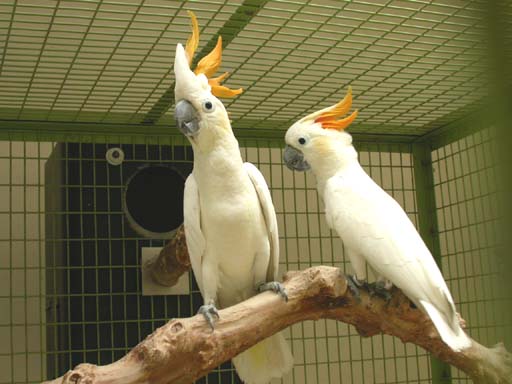
Citron cockatoo, orCitron-crested cockatoo, orSumba cockatoo(Cacatua sulphurea citrinocristata, or Cacatua sulphurea, orPlyctolophus sulphurea)
Phylum —chordata
Class — aves
Order — psittaciformes
Family — cacatuidae
Genus – cacatua
Appearance
The Citron cockatoo is a slightly smaller, quieter, and more subdued variety of the Sulphur-crested cockatoo. Its distinctive orange crest sets it apart from the yellow plumes of the other subspecies. Its personality makes it a popular choice for owners who want to be needed by a pet bird and have the time to do so.
The average Citron-crested cockatoo can be up to 50 cm long and can weigh up to 450 grams.
Habitat
The Citron-crested cockatoo occurs naturally at the island of Sumba in Indonesia.
Behavior
Citron cockatoos are quieter than most cockatoo species, but they still have big personalities and love to play and interact with their owners. This bird is a slightly more withdrawn cockatoo than other varieties, and it may take a bit of time to become acclimated to new surroundings.
Once it feels comfortable, the bird is curious, affectionate, and will want to be by your side as often as possible. This species recommended for a bird owner who has plenty of free time to spend with their pet. Cockatoos, in general, need more human attention than other types of parrots, and the Citron is a classic example.
In general, all cockatoos are intelligent birds with the ability to learn to speak and do tricks like dance, wave, and play fetch.
Diet
In the wild, this bird eats seeds, nuts, berries, and fruits.
Reproduction
When breeding Citron-crested cockatoos, it is of extreme importance that the breeding area includes hiding places where the female can escape should the male become overly aggressive. During breeding season, male Citrons have been known to kill females. Generally, Citron-crested cockatoos become sexually mature between two and four years of age, and should be placed together with a nesting box in a large aviary for breeding. In the wild, mating occurs between September and October. Usually, a T shaped nesting box will be a good choice for the Citron-crested cockatoo. Although Citron-crested cockatoos usually lay two eggs, three is fairly common and up to five is not unknown! These birds usually incubate the eggs for about three and a half to four weeks, and the fledgling period lasts between eight and ten weeks. It may be best to remove the young and hand raise them, as parental aggression is not unknown. Citron- crested cockatoos can breed twice in one year.
In captivity
Citron-crested cockatoos can live up to 40 years, although many die of disease or injury long before they reach that age.
Like all cockatoos, they are social birds that require a lot of human interaction to remain emotionally healthy. Citrons that feel neglected will quickly resort to screaming and destructive behaviors. If you're unable to interact with them, some owners report that their birds appreciate having a television or radio left on; they are especially fond of music.
While Citrons are among the smaller of the cockatoo species, these birds still need plenty of living space. The minimum cage size for a Citron cockatoo is one with a 4-foot long by 4-foot wide and at least 4 feet tall. Bigger is better; an aviary setting is ideal.
All parrots need exercise, and the Citron cockatoo is no exception. Owners should provide a minimum of 3 to 4 hours of time outside of the cage per day so that the bird can play and stretch its muscles. This activity time also provides the essential human contact the birds need. Consider training it to talk and speaking to it during this time to give it the social interaction it craves.
Among the parrots, cockatoos have some of the strongest beaks and jaws. Provide plenty of durable, safe chew toys for them. Expect some of the toys to get shredded. Since birds tend to get bored quickly, rotate the toys in and out often.
Like all cockatoos, Citrons are prone to weight gain, so owners should monitor their fat intake. A healthy diet for a pet Citron cockatoo should consist of high-quality pellets, a daily helping of fresh bird-safe fruits and vegetables, and occasionally seeds or nuts as treats for good behavior. These birds can also eat some proteins in the form of cooked chicken or other meats.
To start, offer approximately 1/4 cup of formulated diet and 1/4 cup of fresh fruits and vegetables daily. If the bird consumes all of its food, incrementally add small amounts as desired. Never feed birds avocados or chocolate; these foods are toxic to them.
 Russian
Russian
 English
English























